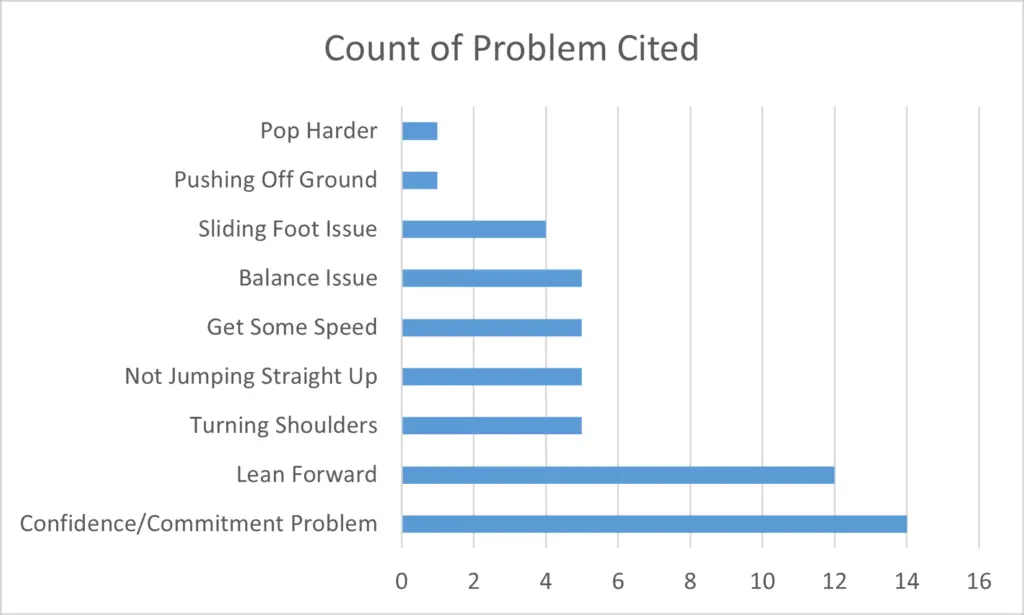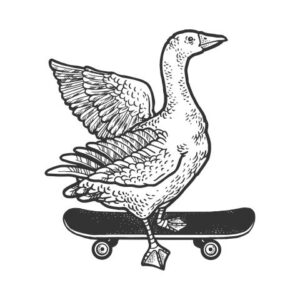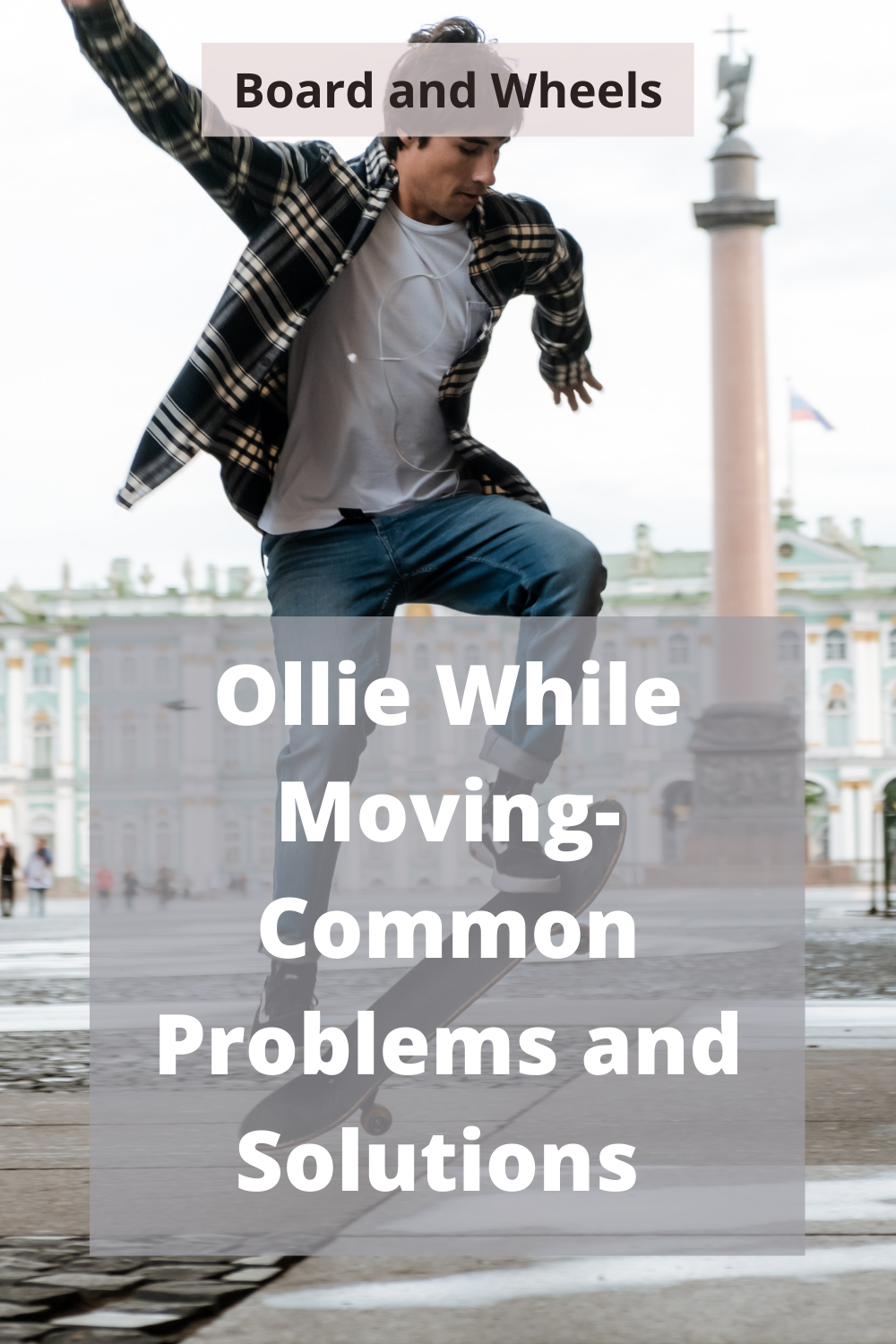It took me a long time to learn how to ollie standing still. Then I had had to relearn how to ollie so I could ollie while moving. Then it took another chunk of time to get decent ollies. But that’s another story.
I asked 52 skaters including myself and a couple of friends whether they had ever had an issue doing an ollie while moving and what was their problem. These are the results.
The most commonly cited problems with doing a moving ollie where lack of confidence/commitment and needing to lean forward. These responses were 27% and 23% of all responses respectively. If you can do an ollie standing still and are having an issue doing a moving ollie, it is very likely that you are not leaning forward or subconsciously bailing early.

You can see that confidence or commitment is the most frequently cited problem. This response was 27% of all responses! Generally, if you can ollie standing still then you have the mechanics to ollie while moving. It really is just an issue of confidence or commitment.
Let’s go through each of these problems and how to fix them in order of most common to least common.
If you need to review the steps of how to actually learn an ollie, you can use my complete beginner’s guide here with pictures and video.
Common Problems and Solutions
If you have issues with doing an ollie while moving, then you most likely have an issue with confidence/commitment or leaning forward. These account for 27% and 23% of all responses.
Let’s go through each response individually and see how we can fix the issue.
Confidence and Commitment Problem
This is the number one cited problem. Most people who could ollie standing still, only had issue doing an ollie while moving because of confidence or a commitment issue.
Solution
The best way to solve this problem is to build up confidence gradually. This is similar to exposure therapy in psychology. You can slowly expose yourself to the thing you fear and over time, you naturally become more comfortable.
Start by going very slow and doing an ollie at a snail’s pace. If you can ollie while inching forward, speed it up a little bit each session. Eventually, you will be comfortable doing an ollie at full speed.
One great trick is to ollie over a small object like a stick or plank of wood. This ensures you have a small goal to focus on and you will be forced to be moving to clear it.
If you want to know about how to over a fear of skating in public you can check out our guide here.
Not Leaning Forward
Not leaning forward is almost mentioned as much as the confidence or commitment issue.
This is simple physics and this was an issue I dealt with as well. When you are moving on a skateboard your forward momentum will try to separate you and your board when you pop. You need to be leaning forward into the direction you are moving to catch your board.
I had an issue doing an ollie moving downhill. This was an extreme example, but my issue was I wasn’t leaning into my ollie. My shoulders weren’t matching the slope of the hill and I wasn’t making enough contact to catch my board.
I eventually fixed this by leaning forward into the slope. It was kind of scary for me at first, but I got comfortable with practice.
Solution
If you are not leaning forward, you likely won’t be catching and leveling out your board. You might also keep landing on your back foot first.
To solve this, focus on your front shoulder when you start your ollie. You need to make sure you are keeping it down and parallel to the ground. Don’t let your shoulder move up when you pop.
Honestly this is a symptom of not committing or a lack of confidence. You are subconsciously preparing for a fall and pulling away from the ground.
Focus specifically on your shoulder, and you will be able to train yourself to ollie while moving in no time.
Turning Shoulders
Turning shoulders is another common issue with doing a moving ollie.
If you turn your shoulders, you will typically land with your chest facing the direction you are moving and your board will likely turn 90 degrees.
This is another common issue if a skater has confidence issues or is not committing. Refer to the confidence issue subheading to learn how to gradually build up your confidence.
This is such a common problem that I wrote an article specifically about turning your shoulders and how to ollie straight that you can find here.
Solution
If you are turning your shoulders while doing an ollie, you need to focus again on your shoulders.
Focus on your shoulders as you pop your ollie. Make sure they stay parallel with the direction you are moving. You can tell if you are turning or not, by the direction of your board. Your baord follows your shoulders.
If you turn your shoulders, your board will turn.
If you still struggle with this, then gradually build up speed for your ollie while focusing on your shoulders. You need to build up confidence doing a moving ollie slowly at first.

Not Jumping Straight Up
If you don’t jump straight up for your ollie, you won’t land on your board. You will likely see your board going in front of you, behind you, or off to the side. This is because your jumping to the side will push the board in the opposite direction.
It can be easy to jump off to the side when you are nervous and anticipating a fall. Like almost all of these issues, this is a symptom of not having confidence and not committing.
Solution
To solve this issue, you will need to build up your speed gradually. If you can jump straight up standing still, you can do it while moving.
You need to train yourself slowly to be comfortable with jumping while there is a moving object beneath you. Naturally, your brain sees this as dangerous and wants to kick it away. Train your muscle memory slowly and you will do it naturally with no issue.
Start off at a snail’s pace and practice your ollie. Slowly build up speed, but only as fast as you can go while keeping good mechanics and jumping straight up.
If you want to know about how much you should practice to progress check out our poll of skater’s opinions here.
Need More Speed
This can be a tricky issue. The forward momentum of a moving ollie makes it easier to balance although this is counter-intuitive.
For this reason, doing an ollie at a snail’s pace can be more difficult than doing one at cruising speed. This is an issue for those who lack the confidence to do a fast ollie yet.
Solution
This is a problem that you will need to feel out for yourself. Doing q slow ollie might be harder, but it’s the best option you have until you are confident enough to pick up speed. Just practice until you find a speed that isn’t too challenging mechanics-wise and isn’t too intimidating for you.
You really really don’t need to be going fast at all.
Balance Issue
Balance issues can cause you to be unable to jump straight up or unable to land on your board cleanly. This just comes from a lack of comfortability on your board.
You need to put in enough time cruising, doing manuals, riding inclines, and everything else to become comfortable on your board. At the very least you should have mastered kick-turns and can cruise comfortably before trying an ollie.
Solution
The solution for this is to ride your board more. That’s it.
Spend more time on your board cruising and skating around a simple skatepark. You will get more comfortable with time. Don’t stop practicing your ollies to do this, but understand that this process just takes time. Your ollie attempts will naturally start to get better.
Not Sliding Foot
This is a critical mechanics issue. Usually, if you can ollie while standing still, then you won’t have this issue. If it seems like your foot isn’t catching on your board, it is more likely that you aren’t leaning forward. This is most likely if you can already ollie while standing still.
This issue will take you back to the basics.
Solution
To solve this go back to the basics.
Practice sliding your foot up your board while standing still on your back tail. Warm-up by doing this for maybe 2-5 minutes.
Then start trying to do the same motion while moving and after popping your skateboard. If you find yourself struggling with this. Keep going back to practicing the sliding of your foot while standing still.
Pushing Off of Ground/Need to Pop Harder
If you are pushing off the ground and not properly popping your board, you won’t catch your board at all. You are not supposed to be jumping off of the ground. You need to pop up your board by snapping your board tail with a flick of your ankle.
Solution
This is a tricky and important mechanic you need to master to ollie. This one is hard to write about so watch this video tutorial that explains this mechanic with visual aids that are easy to follow.
What is the Best How to Ollie Guide?
There are lots of great ollie guides out there. A quick search on YouTube will give you an idea of how many there really are.
My personal favorite for quality and ease of instruction is done by Braille Skateboarding. The host, Aaron Kyro, is a little goofy, but knowledgeable skater.
Visuals aids really help you understand how the mechanics of an ollie work. A picture is worth a thousand words. So we highly recommend that you give his video a watch.
How to Get Over a Fear of Doing a Moving Ollie
If you are afraid of doing a moving ollie, but can do one standing still, then you have a confidence or commitment problem.
This issue can manifest itself in a variety of ways. You might always turn your shoulders or you might jump off to the side. Go through the guide above and try to identify your problem and use the solution provided.
Generally, you will need to build your confidence on your board gradually. Start off by moving very slow and practice your ollies at that speed. With time and practice, you will be able to start doing your ollies at faster and faster speeds.
This really takes time. While I learned an ollie relatively quickly, it took me about 1.5 years to have solid ollies at any speed. Though you can do it faster with more frequent practice. I had to stop practicing for some injuries as well.
If you want to know about when the best time is to go to the skatepark then check out our guide here.
Conclusion
So I hope that this guide helped you on your journey to having clean and high ollies. If you found your problem here, try our solution and see if it helps.
If you don’t know our problem, then go through each problem from the most common to the least common until you start to see some success.
Thanks for reading and look out for more articles from Board and Wheels.
Good luck and get out there and skate.


